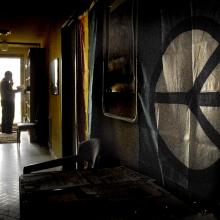seder
Passover is approaching. The first night and its ceremonial meal, the Seder, will come the night of April 19. The night before, Holy Thursday, for Christians commemorates the Last Supper, a Passover Seder. And April 19 is the anniversary of the beginning of the American Revolution against a tyrannical king. It’s a powerful confluence!
We had our fourth annual Passover Seder at Milagro last night. I know, you’re thinking, “what are a bunch of goyim doing celebrating a Jewish tradition?” Given that the central act of our worship service every week – communion – was first introduced by Jesus at his last Seder, we figure if it’s good enough for Jesus, it works for us too.
For the most part, it was a party. But there’s a point at which the leader reads off the ten plagues described in Exodus, none of which is pleasant. For each plague, you dip your finger in a cup of wine and mark the edge of your plate with a crimson dot as a reminder throughout the meal of the suffering experienced by those in captivity.
It’s not exactly a crowd-pleaser, but it’s a valuable symbol, placing in context the joy, food and fellowship that dominate the rest of the evening. Go ahead and enjoy, toast and eat well, but don’t forget.
It got me thinking about what the plagues of our day would be if I were to list them. No, I don’t ascribe to the belief that God sends such horrific episodes upon us as punishment, but I do believe that our free will affords us enough rope to hang ourselves at times, so to speak. Our current plagues are more existential, but the byproducts are often painfully tangible.

Rabbi Allen Secher at his synagogue in Whitefish, Montana. Image via www.thenakedrabbi.com.
Editor's Note: At the beginning of February, the United Nation celebrates World Interfaith Harmony Week. To mark the occasion the Tony Blair Faith Foundation asked people to share their stories of finding friendship and connection with someone of a different faith tradition. This is my story.
When it came time to read from the Torah — handwritten scrolls containing the first five books of the Hebrew Scriptures that are kept in a special ark in every synagogue — something happened I’d never seen or experienced before. The Torah scrolls, which are kept in a blue velvet cover with gold embroidery, were taken down and passed to the congregation. I’d seen men in synagogue hold the scrolls, but I’d never seen them passed this way, from person to person, like the collection basket or the little trays of wine or bread in some of the churches I’d attended over the years.
I’m not Jewish, and in that little gathering of a dozen or so people, I think everyone there knew it. Still, when the scrolls got to me, the woman next to me, without a moment’s hesitation, placed them gently in my arms, like a newborn baby.
I’ve yet to conjure up the words to describe how that moment of inclusion felt. Sacred, yes. Grace-filled, absolutely. But also ancient — tying me to a whole history of a people whom I’d never before thought of as “mine.”
But they are. The Sechers are. The other people at the Bozeman synagogue were. The strangers at the supermarket where we bought matzo and wine were. The people who are reading these words are.
Monks. Al Franken. Oysters. Here's a little roundup of links from around the Web you may have missed this week:
- The Benedictine monks at Portsmouth Abbey take to the Internet in search of new recruits.
- What do you think about the Greg Mortenson controversy?
- iPhones can track your every move and Senator Al Franken is NOT happy about it.
- What would Congress look like if it really represented America?
- Should Christians celebrate Passover? And does an oyster belong on the Seder plate?

